Android includes powerful tools for testing applications. The tools extend JUnit with additional features, provide convenience classes for mock Android system objects, and use instrumentation to give you control over your main application while you are testing it. The entire Android testing environment is discussed in the document Testing Android Applications.
This tutorial demonstrates the Android testing tools by presenting a simple Android application and then leading you step-by-step through the creation of a test application for it. The test application demonstrates these key points:
AndroidManifest.xml file.
TestCase class.
The test application contains methods that perform the following tests:
onCreate() method. Testing initial conditions also provides a confidence measure for subsequent tests.
The instructions and code in this tutorial depend on the following:
If you are not sure which platforms are installed in your SDK, open the Android SDK and AVD Manager and check in the Installed Packages panel. If aren't sure how to download a platform into your SDK, read Adding SDK Components.
During this tutorial, you will be working with sample code that is provided as part of the downloadable Samples component of the SDK. Specifically, you will be working with a pair of related sample applications — an application under test and a test application:
The sample applications are provided in the SDK component named "Samples for SDK API 8" and in later versions of the Samples.
To get started with the tutorial, first use the Android SDK and AVD manager to install an appropriate version of the Samples:
When the installation is complete, the applications in the Samples component are stored at this location on your computer:
<sdk>/samples/android-8/
For general information about the Samples, see Getting the Samples
Note: Although the sample code for this tutorial is provided in the "Samples for SDK API 8" component, that does not imply that you need to build or run the application against the corresponding platform (Android 2.2). The API level referenced in the Samples component name indicates only the origin branch from which the samples were built.
In this tutorial, you will use the Android emulator to run applications. The emulator needs an Android Virtual Device (AVD) with an API level equal to or higher than the one you set for the projects in the previous step. To find out how to check this and create the right AVD if necessary, see Creating an AVD.
As a test of the AVD and emulator, run the SpinnerActivity application in Eclipse with ADT. When it starts, click the large downward-pointing arrow to the right of the spinner text. You see the spinner expand and display the title "Select a planet" at the top. Click one of the other planets. The spinner closes, and your selection appears below it on the screen.
When you are ready to get started with the tutorial, begin by setting up Eclipse projects for both Spinner (the application under test) and SpinnerTest (the test application).
You'll be using the Spinner application as-is, without modification, so you'll be loading it into Eclipse as a new Android project from existing source. In the process, you'll be creating a new test project associated with Spinner that will contain the SpinnerTest application. The SpinnerTest application will be completely new and you'll be using the code examples in this tutorial to add test classes and tests to it.
To install the Spinner app in a new Android project from existing source, following these steps:
<SDK_path>/samples/android-8/Spinner,
then click Open. The directory name <SDK_path>/samples/android-8/Spinner now appears in the Location text box.
<SDK_path>/samples/android-8/Spinner"com.android.example.spinner")The following screenshot summarizes these values:
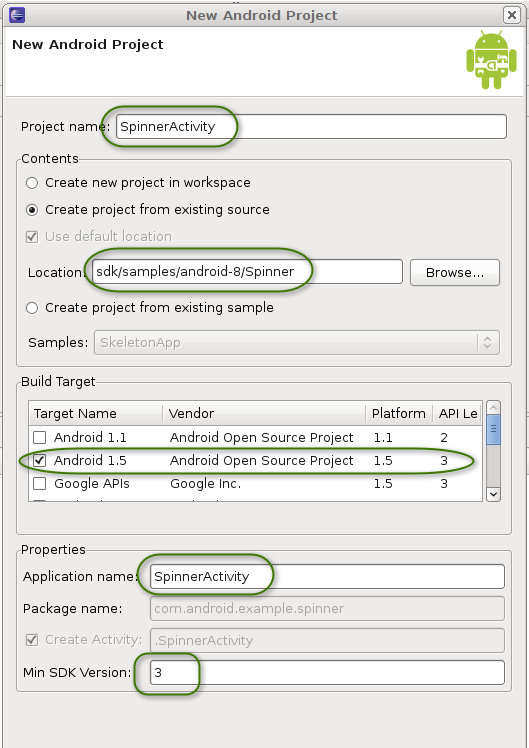
To create a new test project for the SpinnerTest application, follow these steps:
workspace/SpinnerActivityTest").com.android.example.spinner.test"The following screenshot summarizes these values:

Note: If you set Build Target to an API level higher than "3", you will see the warning "The API level for the selected SDK target does not match the Min SDK version". You do not need to change the API level or the Min SDK version. The message tells you that you are building the projects with one particular API level, but specifying that a lower API level is required. This may occur if you have chosen not to install the optional earlier API levels.
If you see errors listed in the Problems pane at the bottom of the Eclipse window, or if a red error marker appears next to the entry for SpinnerActivity in the Package Explorer, highlight the SpinnerActivity entry and then select Project > Clean. This should fix any errors.
You now have the application under test in the SpinnerActivity project, and an empty test project in SpinnerActivityTest. You may notice that the two projects are in different directories, but Eclipse with ADT handles this automatically. You should have no problem in either building or running them.
Notice that Eclipse and ADT have already done some initial setup for your test application.
Expand the SpinnerActivityTest project, and notice that it already has an
Android manifest file AndroidManifest.xml.
Eclipse with ADT created this when you added the test project.
Also, the test application is already set up to use instrumentation. You can see this
by examining AndroidManifest.xml.
Open it, then at the bottom of the center pane click AndroidManifest.xml
to display the XML contents:
<?xml version="1.0" encoding="utf-8"?>
<manifest xmlns:android="http://schemas.android.com/apk/res/android"
package="com.android.example.spinner.test"
android:versionCode="1"
android:versionName="1.0">
<application android:icon="@drawable/icon" android:label="@string/app_name">
<uses-library android:name="android.test.runner" />
</application>
<uses-sdk android:minSdkVersion="3" />
<instrumentation
android:targetPackage="com.android.example.spinner"
android:name="android.test.InstrumentationTestRunner" />
</manifest>
Notice the <instrumentation> element. The attribute
android:targetPackage="com.android.example.spinner" tells Android that the
application under test is defined in the Android package
com.android.example.spinner. Android now knows to use that
package's AndroidManifest.xml file to launch the application under test.
The <instrumentation> element also contains the attribute
android:name="android.test.InstrumentationTestRunner", which tells Android
instrumentation to run the test application with Android's instrumentation-enabled test runner.
You now have a test project SpinnerActivityTest, and the basic structure of a test application also called SpinnerActivityTest. The basic structure includes all the files and directories you need to build and run a test application, except for the class that contains your tests (the test case class).
The next step is to define the test case class. In this tutorial, you'll be creating a test case class that includes:
setUp()
method demonstrates some of the tasks you might perform before running an Android test.
Note: The purpose of testing initial conditions is not the same as
using setUp(). The JUnit setUp() runs once
before each test method, and its purpose is to create a clean test
environment. The initial conditions test runs once, and its purpose is to verify that the
application under test is ready to be tested.
SpinnerActivity application uses them. The test shows the techniques for
verifying that they work.
Android tests are contained in a special type of Android application that contains one or more test class definitions. Each of these contains one or more test methods that do the actual tests. In this tutorial, you will first add a test case class, and then add tests to it.
You first choose an Android test case class to extend. You choose from the base test case classes according to the Android component you are testing and the types of tests you are doing.
In this tutorial, the application under test has a single simple activity, so the test case class will be for an Activity component. Android offers several, but the one that tests in
the most realistic environment is ActivityInstrumentationTestCase2, so you will use it as the base class. Like all activity test case classes,
ActivityInstrumentationTestCase2 offers convenience methods for interacting directly with the UI of the application under test.
To add ActivityInstrumentationTestCase2 as the base test case class, follow these steps:
src/ folder and then the package marker for
com.android.example.spinner.test. Right-click on the package name and select New > Class: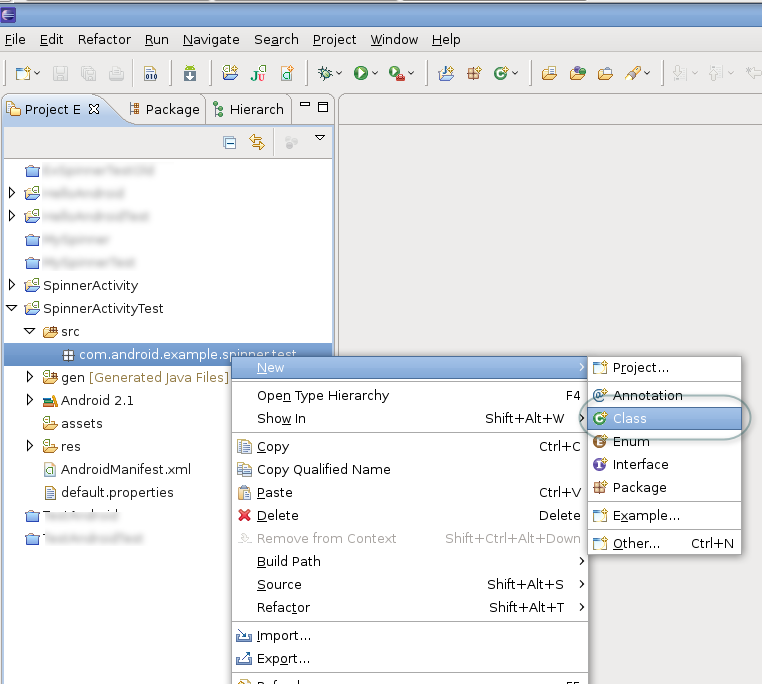
The New Java Class wizard appears:
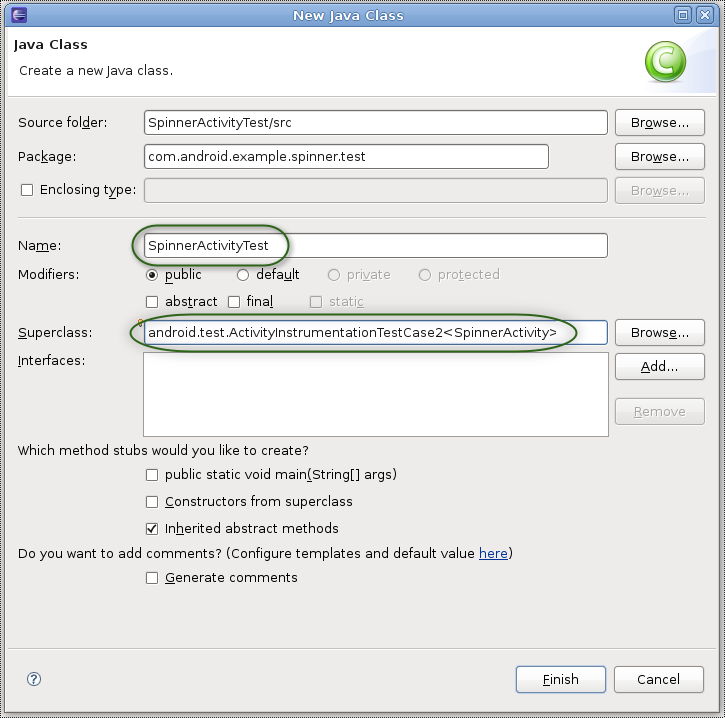
android.test.ActivityInstrumentationTestCase2<SpinnerActivity>". The superclass is parameterized, so
you have to provide it your main application's class name.
Do not change any of the other settings. Click Finish.
SpinnerActivityTest.java in the project.
import com.android.example.spinner.SpinnerActivity;
To ensure that the test application is instantiated correctly, you must set up a constructor that the test runner will call when it instantiates your test class. This constructor has no parameters, and its sole purpose is to pass information to the superclass's default constructor. To set up this constructor, enter the following code in the class:
public SpinnerActivityTest() {
super("com.android.example.spinner", SpinnerActivity.class);
} // end of SpinnerActivityTest constructor definition
This calls the superclass constructor with the Android package name (com.android.example.spinner)and main activity's class
(SpinnerActivity.class) for the application under test. Android uses this information to find the application and activity to test.
You are now ready to add tests, by adding test methods to the class.
The setUp() method is invoked before every test. You use it to initialize variables and clean up from previous tests. You can also use
the JUnit tearDown() method, which runs after every test method. The tutorial does not use it.
The method you are going to add does the following:
super.setUp(). Invokes the superclass constructor for setUp(), which is required by JUnit.
setActivityInitialTouchMode(false).
This turns off touch mode in the device or emulator. If any of your test methods send key events to the application,
you must turn off touch mode before you start any activities; otherwise, the call is ignored.
Spinner
widget used by the activity, the SpinnerAdapter that backs the widget, and the string value of the selection that is
set when the application is first installed. These objects are used in the state management test. The methods invoked are:
getActivity(). Gets a reference to the activity under test (SpinnerActivity).
This call also starts the activity if it is not already running.
findViewById(int). Gets a reference to the Spinner widget of the application under test.
getAdapter(). Gets a reference to the adapter (an array of strings) backing the spinner.
Add this code to the definition of SpinnerActivityTest, after the constructor definition:
@Override
protected void setUp() throws Exception {
super.setUp();
setActivityInitialTouchMode(false);
mActivity = getActivity();
mSpinner =
(Spinner) mActivity.findViewById(
com.android.example.spinner.R.id.Spinner01
);
mPlanetData = mSpinner.getAdapter();
} // end of setUp() method definition
Add these members to the test case class:
private SpinnerActivity mActivity; private Spinner mSpinner; private SpinnerAdapter mPlanetData;
Add these imports:
import android.widget.Spinner; import android.widget.SpinnerAdapter;
You now have the the complete setUp() method.
The initial conditions test verifies that the application under test is initialized correctly. It is an illustration of the types of tests you can run, so it is not comprehensive. It verifies the following:
The actual initialization of the application under test is done in setUp(), which the test runner calls automatically before every test. The verifications are
done with JUnit Assert calls. As a useful convention, the method name is testPreConditions():
public void testPreConditions() {
assertTrue(mSpinner.getOnItemSelectedListener() != null);
assertTrue(mPlanetData != null);
assertEquals(mPlanetData.getCount(),ADAPTER_COUNT);
} // end of testPreConditions() method definition
Add this member:
public static final int ADAPTER_COUNT = 9;
Now create a UI test that selects an item from the Spinner widget. The test sends key events to the UI with key events.
The test confirms that the selection matches the result you expect.
This test demonstrates the power of using instrumentation in Android testing. Only an instrumentation-based test class allows you to send key events (or touch events) to the application under test. With instrumentation, you can test your UI without having to take screenshots, record the screen, or do human-controlled testing.
To work with the spinner, the test has to request focus for it and then set it to a known position. The test uses requestFocus() and
setSelection() to do this. Both of these methods interact with a View in the application under test, so you have to call them
in a special way.
Code in a test application that interacts with a View of the application under test must run in the main application's thread, also
known as the UI thread. To do this, you use the Activity.runOnUiThread()
method. You pass the code to runOnUiThread()in an anonymous Runnable object. To set
the Java statements in the Runnable object, you override the object's run() method.
To send key events to the UI of the application under test, you use the sendKeys() method. This method does not have to run on the UI thread, since Android uses instrumentation to pass the key events to the application under test.
The last part of the test compares the selection made by sending the key events to a pre-determined value. This tests that the spinner is working as intended.
The following sections show you how to add the code for this test.
public void testSpinnerUI(). Add
code to to request focus for the spinner and set its position to default or initial position, "Earth". This code is run on the UI thread of
the application under test:
public void testSpinnerUI() {
mActivity.runOnUiThread(
new Runnable() {
public void run() {
mSpinner.requestFocus();
mSpinner.setSelection(INITIAL_POSITION);
} // end of run() method definition
} // end of anonymous Runnable object instantiation
); // end of invocation of runOnUiThread
Add the following member to the test case class.
public static final int INITIAL_POSITION = 0;
this.sendKeys(KeyEvent.KEYCODE_DPAD_CENTER);
for (int i = 1; i <= TEST_POSITION; i++) {
this.sendKeys(KeyEvent.KEYCODE_DPAD_DOWN);
} // end of for loop
this.sendKeys(KeyEvent.KEYCODE_DPAD_CENTER);
Add the following member to the test case class:
public static final int TEST_POSITION = 5;
This sets the final position of the spinner to "Saturn" (the spinner's backing adapter is 0-based).
getSelectedItemPosition() to find out the current selection position, and then
getItemAtPosition() to get the object corresponding to that position (casting it to a String). Assert that
this string value matches the expected value of "Saturn":
mPos = mSpinner.getSelectedItemPosition();
mSelection = (String)mSpinner.getItemAtPosition(mPos);
TextView resultView =
(TextView) mActivity.findViewById(
com.android.example.spinner.R.id.SpinnerResult
);
String resultText = (String) resultView.getText();
assertEquals(resultText,mSelection);
} // end of testSpinnerUI() method definition
Add the following members to the test case class:
private String mSelection; private int mPos;
Add the following imports to the test case class:
import android.view.KeyEvent; import android.widget.TextView;
Pause here to run the tests you have. The procedure for running a test application is different from running a regular Android application. You run a test application as an Android JUnit application. To see how to do this, see Running the Tests and Seeing the Results.
Eventually, you will see the SpinnerActivity application start, and the test
application controlling it by sending it key events. You will also see a new
JUnit view in the Explorer pane, showing the results of the
test. The JUnit view is documented in a following section,
Running the Test and Seeing the Results.
You now write two tests that verify that SpinnerActivity maintains its state when it is paused or terminated. The state, in this case, is the current selection in the spinner. When users make a selection, pause or terminate the application, and then resume or restart it, they should see the same selection.
Maintaining state is an important feature of an application. Users may switch from the current application temporarily to answer the phone, and then switch back. Android may decide to terminate and restart an activity to change the screen orientation, or terminate an unused activity to regain storage. In each case, users are best served by having the UI return to its previous state (except where the logic of the application dictates otherwise).
SpinnerActivity manages its state in these ways:
Note: An application can manage its state in other ways as well, but these are not covered in this tutorial.
When an activity is hidden, it is paused. When it re-appears, it
resumes. Recognizing that these are key points in an activity's life cycle,
the Activity class provides two callback methods onPause() and
onResume() for handling pauses and resumes.
SpinnerActivity uses them for code that saves and restores state.
Note: If you would like to learn more about the difference between losing focus/pausing and killing an application, refer to the Activity Lifecycle section.
The first test verifies that the spinner selection is maintained after the entire application is shut down and then restarted. The test uses instrumentation to
set the spinner's variables outside of the UI. It then terminates the activity by calling Activity.finish(), and restarts it
using the instrumentation method getActivity(). The test then asserts that the current spinner state matches
the test values.
The second test verifies that the spinner selection is maintained after the activity is paused and then resumed. The test uses instrumentation to
set the spinner's variables outside of the UI and then force calls to the onPause() and onResume() methods. The test then
asserts that the current spinner state matches the test values.
Notice that these tests make limited assumptions about the mechanism by which the activity manages state. The tests use the activity's getters and
setters to control the spinner. The first test also knows that hiding an activity calls onPause(), and bringing it back to the foreground
calls onResume(). Other than this, the tests treat the activity as a "black box".
To add the code for testing state management across shutdown and restart, follow these steps:
testStateDestroy(), then
set the spinner selection to a test value:
public void testStateDestroy() {
mActivity.setSpinnerPosition(TEST_STATE_DESTROY_POSITION);
mActivity.setSpinnerSelection(TEST_STATE_DESTROY_SELECTION);
mActivity.finish();
mActivity = this.getActivity();
int currentPosition = mActivity.getSpinnerPosition();
String currentSelection = mActivity.getSpinnerSelection();
assertEquals(TEST_STATE_DESTROY_POSITION, currentPosition);
assertEquals(TEST_STATE_DESTROY_SELECTION, currentSelection);
} // end of testStateDestroy() method definition
Add the following members to the test case class:
public static final int TEST_STATE_DESTROY_POSITION = 2; public static final String TEST_STATE_DESTROY_SELECTION = "Earth";
To add the code for testing state management across a pause and resume, follow these steps:
testStatePause():
@UiThreadTest
public void testStatePause() {
The @UiThreadTest annotation tells Android to build this method so that it runs
on the UI thread. This allows the method to change the state of the spinner widget in the
application under test. This use of @UiThreadTest shows that, if necessary, you
can run an entire method on the UI thread.
onPause() and onResume() methods:
Instrumentation mInstr = this.getInstrumentation();
mActivity.setSpinnerPosition(TEST_STATE_PAUSE_POSITION);
mActivity.setSpinnerSelection(TEST_STATE_PAUSE_SELECTION);
onPause():
mInstr.callActivityOnPause(mActivity);
Under test, the activity is waiting for input. The invocation of
callActivityOnPause(android.app.Activity)
performs a call directly to the activity's onPause() instead
of manipulating the activity's UI to force it into a paused state.
mActivity.setSpinnerPosition(0);
mActivity.setSpinnerSelection("");
This ensures that resuming the activity actually restores the spinner's state rather than simply leaving it as it was.
onResume():
mInstr.callActivityOnResume(mActivity);
Invoking callActivityOnResume(android.app.Activity)
affects the activity in a way similar to callActivityOnPause. The
activity's onResume() method is invoked instead of manipulating the
activity's UI to force it to resume.
int currentPosition = mActivity.getSpinnerPosition();
String currentSelection = mActivity.getSpinnerSelection();
assertEquals(TEST_STATE_PAUSE_POSITION,currentPosition);
assertEquals(TEST_STATE_PAUSE_SELECTION,currentSelection);
} // end of testStatePause() method definition
Add the following members to the test case class:
public static final int TEST_STATE_PAUSE_POSITION = 4; public static final String TEST_STATE_PAUSE_SELECTION = "Jupiter";
import android.app.Instrumentation; import android.test.UiThreadTest;
The most simple way to run the SpinnerActivityTest test case is to run it directly from the Package Explorer.
To run the SpinnerActivityTest test, follow these steps:

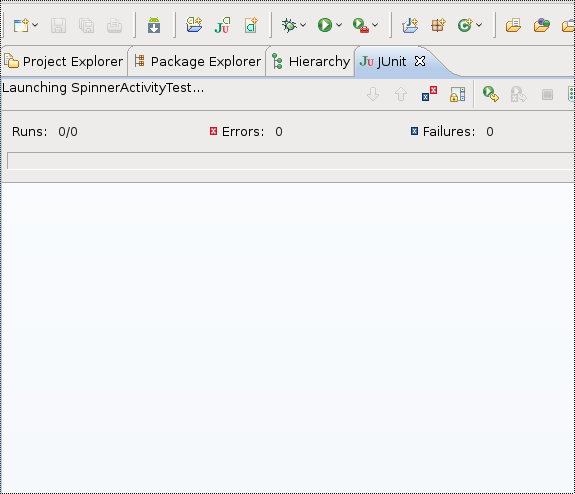
This view contains two sub-panes. The top pane summarizes the tests that were run, and the bottom pane shows failure traces for highlighted tests.
At the conclusion of a successful test run, this is the view's appearance:
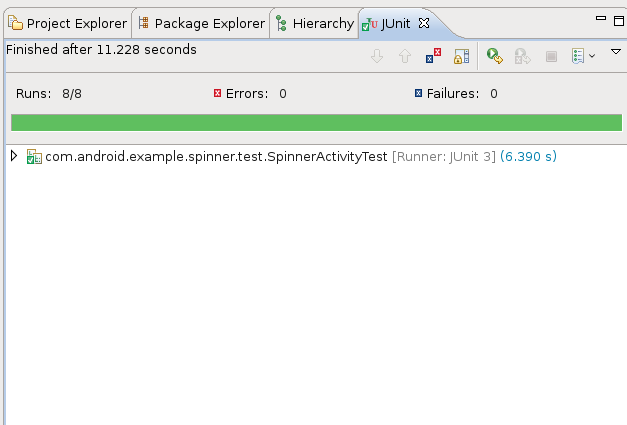
The upper pane summarizes the test:
If all the tests succeed, the bar remains green. If a test fails, the bar turns from green to red.
The lower pane contains the failure trace. If all the tests are successful, this pane is empty. If some tests fail, then if you highlight a failed test in the upper pane, the lower view contains a stack trace for the test. This is demonstrated in the next section.
Note: If you run the test application and nothing seems to happen, look for the JUnit view. If you do not see it, you may have run the test application as a regular Android application. Remember that you need to run it as an Android JUnit application.
A test is as useful when it fails as when it succeeds. This section shows what happens in Eclipse with ADT when a test fails. You can quickly see that a test class has failed, find the method or methods that failed, and then use a failure trace to find the exact problem.
The example application SpinnerActivity that you downloaded passes all the tests in the test application SpinnerActivityTest.
To force the test to fail, you must modify the example application. You change a line of setup code in the application under test. This
causes the testPreConditions() and testTextView() test methods to fail.
To force the tests to fail, follow these steps:
SpinnerActivity.java.
SpinnerActivity.java, at the end of the onCreate() method, find the following line:
// mySpinner.setOnItemSelectedListener(null);
Remove the forward slash characters at the beginning of the line to uncomment the line. This sets the listener callback to null:
mySpinner.setOnItemSelectedListener(null);
testPreConditions() method in SpinnerActivityTest contains the following test:
assertTrue(mSpinner.getOnItemSelectedListener() != null);. This test asserts that the listener callback is not null.
Since you have modified the application under test, this assertion now fails.
The JUnit view is either created or updated with the results of the test. Now, however, the progress bar is red,
the number of failures is 2, and small "x" icons appear in the list icons next to the testPreConditions and
TestSpinnerUI tests. This indicates that the tests have failed. The display is similar to this:
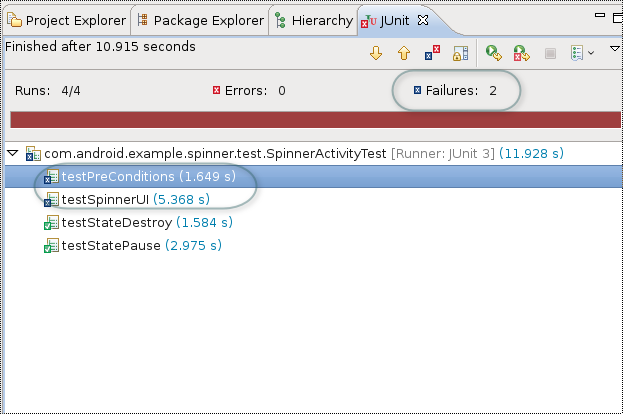
You now want to look at the failures to see exactly where they occurred.
To examine the failures, follow these steps:
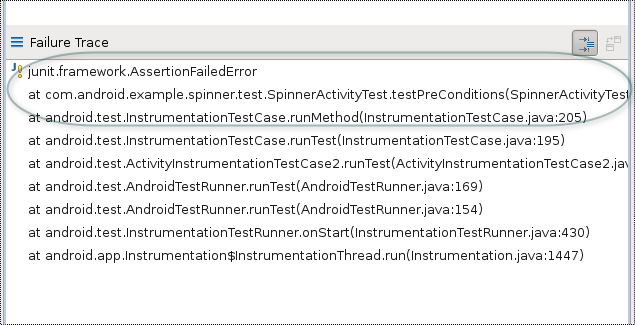
SpinnerActivityTest. The failed assertion
is highlighted in the middle of the window.
The assertion failed because you modified the main application to set the getOnItemSelectedListener callback to null.
You can look at the failure in testTextView if you want. Remember, though, that testPreConditions is meant to verify the
initial setup of the application under test. If testPreConditions() fails, then succeeding tests can't be trusted. The best strategy to follow is to
fix the problem and re-run all the tests.
Remember to go back to SpinnerActivity.java and re-comment the line you uncommented in an earlier step.
You have now completed the tutorial.
This example test application has shown you how to create a test project and link it to the application you want to test, how to choose and add a test case class, how to write UI and state management tests, and how to run the tests against the application under test. Now that you are familiar with the basics of testing Android applications, here are some suggested next steps:
Learn more about testing on Android
Review the main Android test case classes
Learn more about the assert and utility classes
Assert, the JUnit Assert class.
MoreAsserts, additional Android assert methods.
ViewAsserts, useful assertion methods for testing Views.
TouchUtils, utility methods for simulating touch events in an Activity.
Learn about instrumentation and the instrumented test runner
Instrumentation, the base instrumentation class.
InstrumentationTestCase, the base instrumentation test case.
InstrumentationTestRunner, the standard Android test runner.
The recommended approach to this tutorial is to follow the instructions step-by-step and write the test code as you go. However, if you want to do this tutorial quickly, you can install the entire Java file for the test application into the test project.
To do this, you first create a test project with the necessary structure and files by using the automated tools in Eclipse. Then you exit Eclipse and copy the test application's Java file from the SpinnerTest sample project into your test project. The SpinnerTest sample project is part of the Samples component of the SDK.
The result is a complete test application, ready to run against the Spinner sample application.
To install the test application Java file, follow these steps:
<SDK_path>/samples/android-8/SpinnerTest/src/com/android/example/spinner/test/SpinnerActivityTest.java
to the directory workspace/SpinnerActivityTest/src/com/android/example/spinner/test/.
SpinnerActivityTest by selecting it in the Package Explorer, right-clicking,
and selecting Project > Clean.
SpinnerActivityTest project.
You can now continue with the tutorial, starting at the section Adding the test case constructor and following along in the text.
If you are not developing in Eclipse, you can still do this tutorial. Android provides tools for creating test applications using a code editor and command-line tools. You use the following tools:
You use the emulator tool to run the emulator from the command line.
Here are the general steps for doing this tutorial using an editor and the command line:
<SDK_path>/samples/android-8, containing (among others) the directories Spinner
and SpinnerTest:
Spinner contains the main application, also known as the application under test. This tutorial focuses on the
common situation of writing tests for an application that already exists, so the main application is provided to you.
SpinnerTest contains all the code for the test application. If you want to run quickly through the tutorial, you can
install the test code and then follow the text. You may get more from the tutorial, however, if you write the code as you go. The instructions
for installing the test code are in the section Appendix: Installing the Completed Test Application.
<SDK_path>/samples/android-8.
android create project:
$ android create project -t <APItarget> -k com.android.example.spinner -a SpinnerActivity -n SpinnerActivity -p Spinner
The value of <APItarget> should be "3" (API level 3) or higher. If you are already developing with a particular API level, and it is
higher than 3, then use that API level.
This a new Android project SpinnerActivity in the existing Spinner directory. The existing source and
resource files are not touched, but the android tool adds the necessary build files.
android create test-project:
$ android create test-project -m ../Spinner -n SpinnerActivityTest -p SpinnerActivityTest
This will create a new Android test project in the new directory SpinnerActivityTest. You do this
so that the solution to the tutorial that is in SpinnerTest is left untouched. If you want to use the solution
code instead of entering it as you read through the tutorial, refer to the section
Appendix: Installing the Completed Test Application.
Note: Running android create test-project will automatically create
the file AndroidManifest.xml with the correct <instrumentation> element.
ant debug to build a debug version, since the SDK comes
with a debug signing key. The result will be the file Spinner/bin/SpinnerActivity-debug.apk.
You can install this to your device or emulator. Attach your device or start the emulator if you haven't already, and run the command:
$ adb install Spinner/bin/SpinnerActivity-debug.apk
SpinnerActivityTest.java in the directory
SpinnerActivityTest/src/com/android/example/spinner/test/.
ant debug to build a
debug version, since the SDK comes with a debug signing key. The result will be the Android file
SpinnerActivityTest/bin/SpinnerActivityTest-debug.apk. You can install this to your device or emulator.
Attach your device or start the emulator if you haven't already, and run the command:
$ adb install SpinnerActivityTest/bin/SpinnerActivityTest-debug.apk
SpinnerActivity and the test application
SpinnerActivityTest are installed.
$ adb shell am instrument -w com.android.example.spinner.test/android.test.InstrumentationTestRunner
The result of a successful test looks like this:
com.android.example.spinner.test.SpinnerActivityTest:.... Test results for InstrumentationTestRunner=.... Time: 10.098 OK (4 tests)
If you force the test to fail, as described in the previous section Forcing Some Tests to Fail, then the output looks like this:
com.android.example.spinner.test.SpinnerActivityTest: Failure in testPreConditions: junit.framework.AssertionFailedError at com.android.example.spinner.test.SpinnerActivityTest.testPreConditions(SpinnerActivityTest.java:104) at java.lang.reflect.Method.invokeNative(Native Method) at android.test.InstrumentationTestCase.runMethod(InstrumentationTestCase.java:205) at android.test.InstrumentationTestCase.runTest(InstrumentationTestCase.java:195) at android.test.ActivityInstrumentationTestCase2.runTest(ActivityInstrumentationTestCase2.java:175) at android.test.AndroidTestRunner.runTest(AndroidTestRunner.java:169) at android.test.AndroidTestRunner.runTest(AndroidTestRunner.java:154) at android.test.InstrumentationTestRunner.onStart(InstrumentationTestRunner.java:430) at android.app.Instrumentation$InstrumentationThread.run(Instrumentation.java:1447) Failure in testSpinnerUI: junit.framework.ComparisonFailure: expected:<Result> but was:<Saturn> at com.android.example.spinner.test.SpinnerActivityTest.testSpinnerUI(SpinnerActivityTest.java:153) at java.lang.reflect.Method.invokeNative(Native Method) at android.test.InstrumentationTestCase.runMethod(InstrumentationTestCase.java:205) at android.test.InstrumentationTestCase.runTest(InstrumentationTestCase.java:195) at android.test.ActivityInstrumentationTestCase2.runTest(ActivityInstrumentationTestCase2.java:175) at android.test.AndroidTestRunner.runTest(AndroidTestRunner.java:169) at android.test.AndroidTestRunner.runTest(AndroidTestRunner.java:154) at android.test.InstrumentationTestRunner.onStart(InstrumentationTestRunner.java:430) at android.app.Instrumentation$InstrumentationThread.run(Instrumentation.java:1447) .. Test results for InstrumentationTestRunner=.F.F.. Time: 9.377 FAILURES!!! Tests run: 4, Failures: 2, Errors: 0